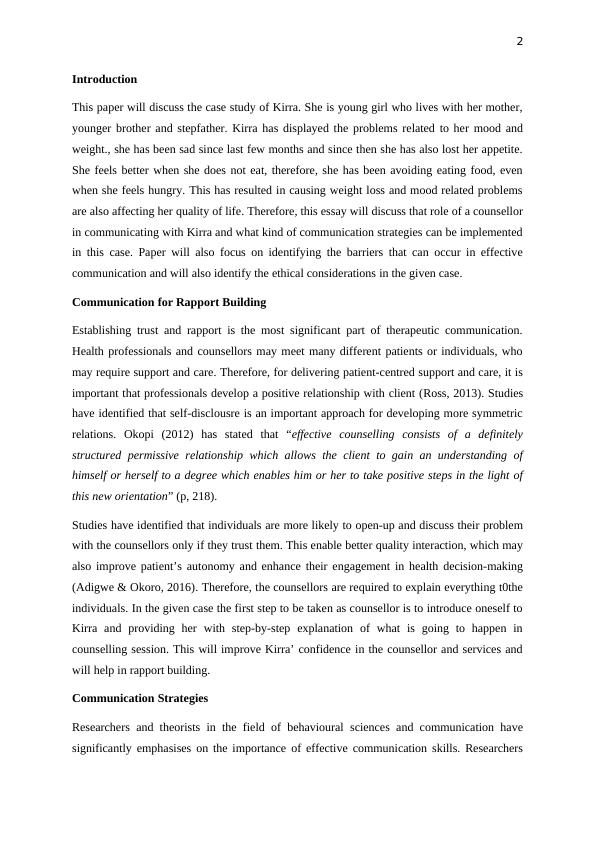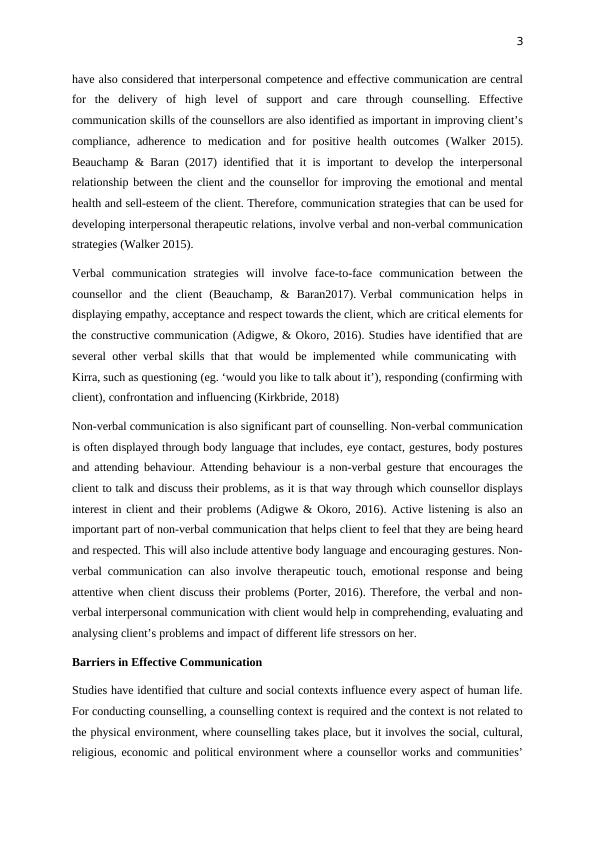Strategies of Effective Communication
Added on 2022-11-29
7 Pages2465 Words211 Views
1
Strategies of Effective Communication
Strategies of Effective Communication

2
Introduction
This paper will discuss the case study of Kirra. She is young girl who lives with her mother,
younger brother and stepfather. Kirra has displayed the problems related to her mood and
weight., she has been sad since last few months and since then she has also lost her appetite.
She feels better when she does not eat, therefore, she has been avoiding eating food, even
when she feels hungry. This has resulted in causing weight loss and mood related problems
are also affecting her quality of life. Therefore, this essay will discuss that role of a counsellor
in communicating with Kirra and what kind of communication strategies can be implemented
in this case. Paper will also focus on identifying the barriers that can occur in effective
communication and will also identify the ethical considerations in the given case.
Communication for Rapport Building
Establishing trust and rapport is the most significant part of therapeutic communication.
Health professionals and counsellors may meet many different patients or individuals, who
may require support and care. Therefore, for delivering patient-centred support and care, it is
important that professionals develop a positive relationship with client (Ross, 2013). Studies
have identified that self-disclousre is an important approach for developing more symmetric
relations. Okopi (2012) has stated that “effective counselling consists of a definitely
structured permissive relationship which allows the client to gain an understanding of
himself or herself to a degree which enables him or her to take positive steps in the light of
this new orientation” (p, 218).
Studies have identified that individuals are more likely to open-up and discuss their problem
with the counsellors only if they trust them. This enable better quality interaction, which may
also improve patient’s autonomy and enhance their engagement in health decision-making
(Adigwe & Okoro, 2016). Therefore, the counsellors are required to explain everything t0the
individuals. In the given case the first step to be taken as counsellor is to introduce oneself to
Kirra and providing her with step-by-step explanation of what is going to happen in
counselling session. This will improve Kirra’ confidence in the counsellor and services and
will help in rapport building.
Communication Strategies
Researchers and theorists in the field of behavioural sciences and communication have
significantly emphasises on the importance of effective communication skills. Researchers
Introduction
This paper will discuss the case study of Kirra. She is young girl who lives with her mother,
younger brother and stepfather. Kirra has displayed the problems related to her mood and
weight., she has been sad since last few months and since then she has also lost her appetite.
She feels better when she does not eat, therefore, she has been avoiding eating food, even
when she feels hungry. This has resulted in causing weight loss and mood related problems
are also affecting her quality of life. Therefore, this essay will discuss that role of a counsellor
in communicating with Kirra and what kind of communication strategies can be implemented
in this case. Paper will also focus on identifying the barriers that can occur in effective
communication and will also identify the ethical considerations in the given case.
Communication for Rapport Building
Establishing trust and rapport is the most significant part of therapeutic communication.
Health professionals and counsellors may meet many different patients or individuals, who
may require support and care. Therefore, for delivering patient-centred support and care, it is
important that professionals develop a positive relationship with client (Ross, 2013). Studies
have identified that self-disclousre is an important approach for developing more symmetric
relations. Okopi (2012) has stated that “effective counselling consists of a definitely
structured permissive relationship which allows the client to gain an understanding of
himself or herself to a degree which enables him or her to take positive steps in the light of
this new orientation” (p, 218).
Studies have identified that individuals are more likely to open-up and discuss their problem
with the counsellors only if they trust them. This enable better quality interaction, which may
also improve patient’s autonomy and enhance their engagement in health decision-making
(Adigwe & Okoro, 2016). Therefore, the counsellors are required to explain everything t0the
individuals. In the given case the first step to be taken as counsellor is to introduce oneself to
Kirra and providing her with step-by-step explanation of what is going to happen in
counselling session. This will improve Kirra’ confidence in the counsellor and services and
will help in rapport building.
Communication Strategies
Researchers and theorists in the field of behavioural sciences and communication have
significantly emphasises on the importance of effective communication skills. Researchers

3
have also considered that interpersonal competence and effective communication are central
for the delivery of high level of support and care through counselling. Effective
communication skills of the counsellors are also identified as important in improving client’s
compliance, adherence to medication and for positive health outcomes (Walker 2015).
Beauchamp & Baran (2017) identified that it is important to develop the interpersonal
relationship between the client and the counsellor for improving the emotional and mental
health and sell-esteem of the client. Therefore, communication strategies that can be used for
developing interpersonal therapeutic relations, involve verbal and non-verbal communication
strategies (Walker 2015).
Verbal communication strategies will involve face-to-face communication between the
counsellor and the client (Beauchamp, & Baran2017). Verbal communication helps in
displaying empathy, acceptance and respect towards the client, which are critical elements for
the constructive communication (Adigwe, & Okoro, 2016). Studies have identified that are
several other verbal skills that that would be implemented while communicating with
Kirra, such as questioning (eg. ‘would you like to talk about it’), responding (confirming with
client), confrontation and influencing (Kirkbride, 2018)
Non-verbal communication is also significant part of counselling. Non-verbal communication
is often displayed through body language that includes, eye contact, gestures, body postures
and attending behaviour. Attending behaviour is a non-verbal gesture that encourages the
client to talk and discuss their problems, as it is that way through which counsellor displays
interest in client and their problems (Adigwe & Okoro, 2016). Active listening is also an
important part of non-verbal communication that helps client to feel that they are being heard
and respected. This will also include attentive body language and encouraging gestures. Non-
verbal communication can also involve therapeutic touch, emotional response and being
attentive when client discuss their problems (Porter, 2016). Therefore, the verbal and non-
verbal interpersonal communication with client would help in comprehending, evaluating and
analysing client’s problems and impact of different life stressors on her.
Barriers in Effective Communication
Studies have identified that culture and social contexts influence every aspect of human life.
For conducting counselling, a counselling context is required and the context is not related to
the physical environment, where counselling takes place, but it involves the social, cultural,
religious, economic and political environment where a counsellor works and communities’
have also considered that interpersonal competence and effective communication are central
for the delivery of high level of support and care through counselling. Effective
communication skills of the counsellors are also identified as important in improving client’s
compliance, adherence to medication and for positive health outcomes (Walker 2015).
Beauchamp & Baran (2017) identified that it is important to develop the interpersonal
relationship between the client and the counsellor for improving the emotional and mental
health and sell-esteem of the client. Therefore, communication strategies that can be used for
developing interpersonal therapeutic relations, involve verbal and non-verbal communication
strategies (Walker 2015).
Verbal communication strategies will involve face-to-face communication between the
counsellor and the client (Beauchamp, & Baran2017). Verbal communication helps in
displaying empathy, acceptance and respect towards the client, which are critical elements for
the constructive communication (Adigwe, & Okoro, 2016). Studies have identified that are
several other verbal skills that that would be implemented while communicating with
Kirra, such as questioning (eg. ‘would you like to talk about it’), responding (confirming with
client), confrontation and influencing (Kirkbride, 2018)
Non-verbal communication is also significant part of counselling. Non-verbal communication
is often displayed through body language that includes, eye contact, gestures, body postures
and attending behaviour. Attending behaviour is a non-verbal gesture that encourages the
client to talk and discuss their problems, as it is that way through which counsellor displays
interest in client and their problems (Adigwe & Okoro, 2016). Active listening is also an
important part of non-verbal communication that helps client to feel that they are being heard
and respected. This will also include attentive body language and encouraging gestures. Non-
verbal communication can also involve therapeutic touch, emotional response and being
attentive when client discuss their problems (Porter, 2016). Therefore, the verbal and non-
verbal interpersonal communication with client would help in comprehending, evaluating and
analysing client’s problems and impact of different life stressors on her.
Barriers in Effective Communication
Studies have identified that culture and social contexts influence every aspect of human life.
For conducting counselling, a counselling context is required and the context is not related to
the physical environment, where counselling takes place, but it involves the social, cultural,
religious, economic and political environment where a counsellor works and communities’

End of preview
Want to access all the pages? Upload your documents or become a member.
Related Documents
Communication Skillslg...
|8
|2084
|143
Communication in Nursing - Importance and Strategieslg...
|8
|2213
|295
Communication for Health Professionalslg...
|8
|1713
|492
Communication for Health Professionalslg...
|8
|2270
|307
Communication in Nursing Assignment Paperlg...
|9
|2155
|390
Nursing Assignment Solution Paperlg...
|7
|2017
|57